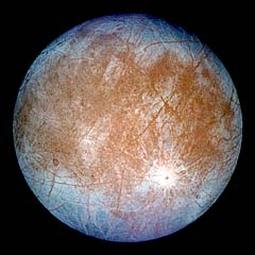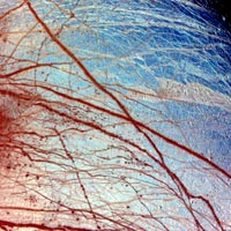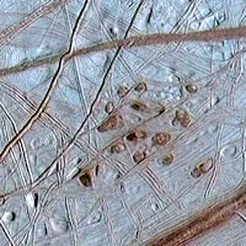Our Solar System
Europa

Europa's surface is among the brightest in the solar system, a consequence of sunlight reflecting off a relatively young icy crust. Its face is also among the smoothest, lacking the heavily cratered appearance characteristic of Callisto and Ganymede. Lines and cracks wrap the exterior as if a child had scribbled around it. Europa may be internally active, and its crust may have, or had in the past, liquid water which can harbor life.
A Frozen Ocean

Europa is very different from the other moons of Jupiter. Instead of a rocky, cratered surface like Callisto and Ganymede, it instead has a smooth outer surface of cracked ice. There are very few sign of craters on Europa. In fact, only three large craters have been found. This indicates that Europa's surface is very young and active. In photographs sent back by the Voyager and Galileo probes, the surface resembles sea ice on Earth. Astronomers believe that beneath this layer of ice may exist an ocean, kept liquid by the moon's internal heat. This liquid ocean could be as much as 30 miles deep. The existence of deep ocean vents on the ocean floor on Earth have led some scientists to speculate that there could be a possibility of life on Europa. Around these deep sea vents on Earth are life forms that do not need sunlight to survive. They instead feed on bacteria that get their nutrients from chemicals seeping up from the ocean floor. This process is known as chemosynthesis. Scientists believe that similar life forms could evolve on Europa if a liquid ocean does indeed exist beneath its frozen surface.
Features of Europa

The most apparent features on Europa are a series of dark streaks crisscrossing the entire surface of the moon. Astronomers believe that these marks may have been formed by a series of volcanic eruptions or geysers. Another theory is that tidal forces cause the frozen surface of Europa to crack. Water from the interior then flows through the cracks and refreezes. Like Ganymede, Europa was long thought to have no atmosphere. But recent observations with the Hubble space telescope indicate that a thin atmosphere of oxygen exists. It is believed to have been formed by sunlight and charged particles interacting with water particles on the surface. It is a process very similar to that which takes place on Ganymede. Recent data from the Galileo mission supports the theory of a liquid ocean beneath Europa's surface. If this can be proven, Europa will remain one of the prime candidates for extraterrestrial life in our solar system.
Statistics for Europa
Discovered by - Galileo Galilei & Simon Marius
Year of Discovery - 1610
Diameter - 1,940 miles (3,122 km)
Mean Distance from Jupiter - 417,002 miles (671,100 km)
Rotational Period - 3.55 days
Orbital Period - 3.55 days
Orbital Eccentricity - 0.009
Orbital Inclination - 0.47 degrees
Main Atmospheric Component - None
Apparent Magnitude - 5.29
Year of Discovery - 1610
Diameter - 1,940 miles (3,122 km)
Mean Distance from Jupiter - 417,002 miles (671,100 km)
Rotational Period - 3.55 days
Orbital Period - 3.55 days
Orbital Eccentricity - 0.009
Orbital Inclination - 0.47 degrees
Main Atmospheric Component - None
Apparent Magnitude - 5.29
